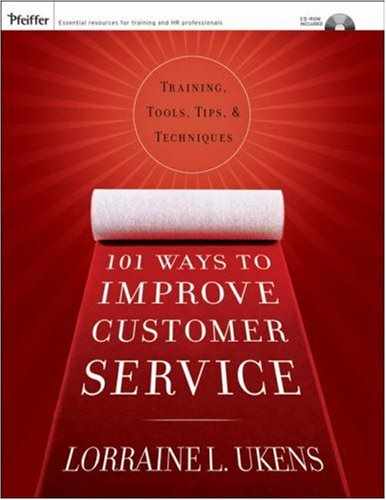Problem solving plays a significant role in the customer service process. Although there are a variety of approaches, the key to finding a proper solution generally comes from extensive investigation and observation. A search for patterns leads to logical conclusions, but people need to remain flexible enough to allow for changes in the thinking model as new information is collected. Therefore, good service involves creative, “outside-the-box” thinking. Those who give the best service do so by offering customers options, alternatives, and new ways of doing things.
To acquire this logical yet creative kind of problem-solving mind-set, service representatives must recognize when things are wrong and then do something to change them. This requires remaining open to recommendations and being flexible when particular circumstances may require deviations from policy in order to meet customer needs. The key to accomplishing this type of problem solving involves comprehending the entire scope of the problem before developing a solution for it.
Showing genuine interest in the needs or problems of a customer is essential to building a successful partnering relationship. By treating each client equitably, but not necessarily uniformly, and looking for as many alternatives to the solution as possible, a representative will find it easier to match what the customer wants to what he or she can offer. What solves a problem for one customer doesn’t necessarily solve a similar problem for another customer. However, a service provider must not create overly disparate solutions for various customers, or a particular client may feel slighted. As the employee works to create the solution, he or she should speak in positive terms and express the benefits of the solution to the customer.
Because the problem-solving process may result in differing ideas and viewpoints, conflict can be a natural outcome. Differences often can be used to provide the necessary boost to creative problem solving, but if they cannot be resolved, conflict becomes a negative influence. Conflict management requires flexibility and constant evaluation to be truly effective, and communication plays a significant role in the overall process.
Another part of the problem-solving process involves negotiation. Successful negotiation satisfies as much as possible the legitimate interests of all parties; that is, all parties find the terms to be an agreeable solution, judged by objective standards. At the same time, a good working relationship has to be maintained. Service providers must approach negotiation with an open mind and avoid preconceived perceptions. In this way, they can negotiate solutions that are satisfying to the customer and still meet company policies.
Most important, service providers must include personal communications with customers as a key part of the problem-solving strategy. Responding personally creates an opportunity for dialogue with customers—an opportunity to listen, ask questions, explain, apologize, and achieve closure.
In the pursuit of excellence, service providers must use superior problem-solving skills to understand all aspects of the specific problem and to search for solutions that are acceptable. This means examining underlying issues and taking time to prevent problems in the future. A problem-solving attitude doesn’t necessarily mean looking at everything as a problem, but rather thinking about what is happening, what outcomes are expected, and what alternatives might be. This mind-set is an active and creative one that keeps the employee alert and involved in any interaction.
